North America WiGig Market Size
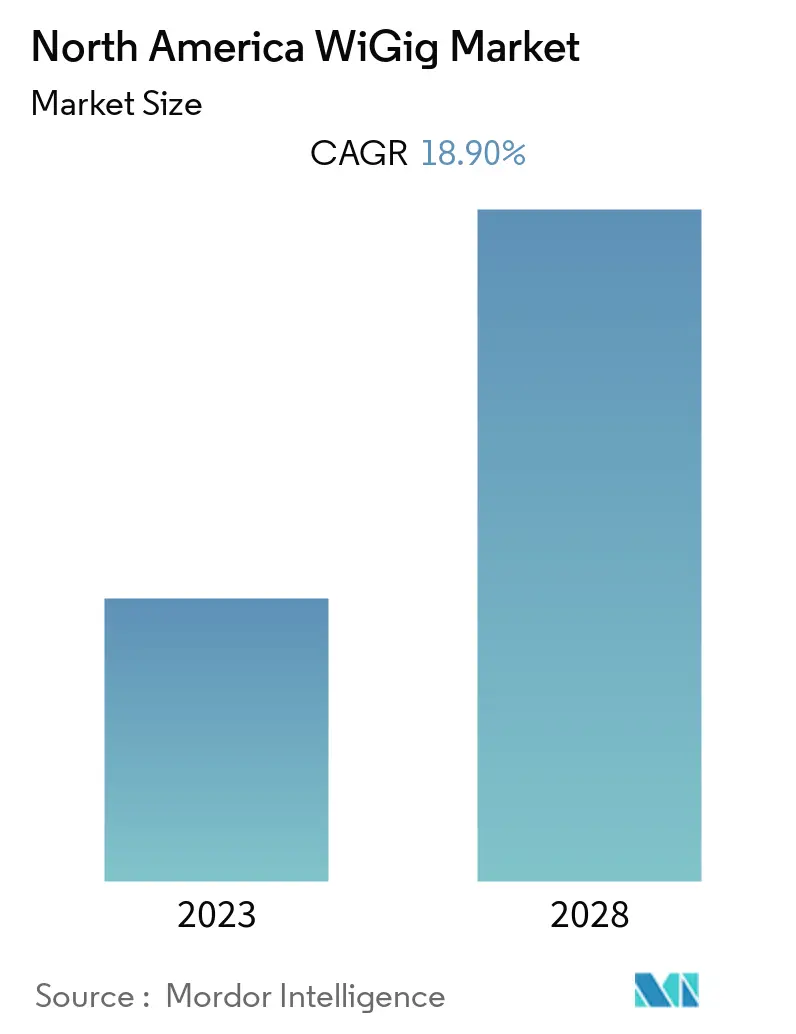
| Study Period | 2018 - 2028 |
| Base Year For Estimation | 2021 |
| Forecast Data Period | 2024 - 2028 |
| Historical Data Period | 2018 - 2020 |
| CAGR | 18.90 % |
| Market Concentration | High |
Major Players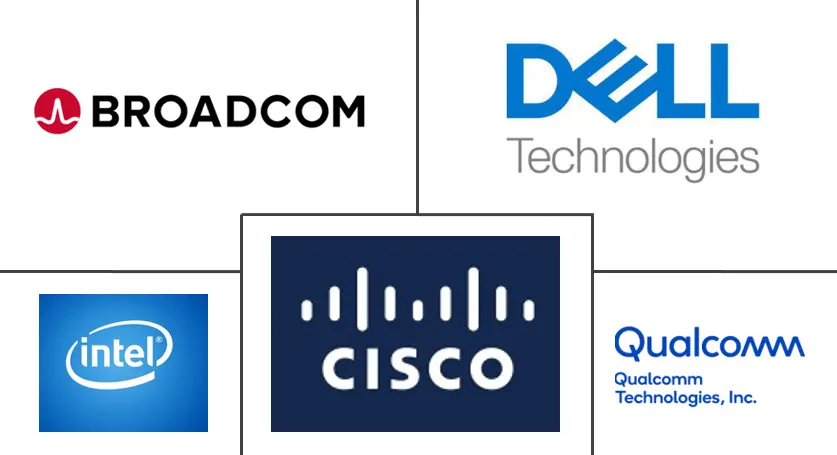
*Disclaimer: Major Players sorted in no particular order |
Need a report that reflects how COVID-19 has impacted this market and its growth?
North America WiGig Market Analysis
The WiGig Market in North Americais expected to grow at a CAGR of 18.9%, during the period of 2020-2025 . One of the issues with the popular wireless standards currently is that they either have very limited bandwidth (e.g. Bluetooth), or they’re subject to inconsistent performance, due to interference and congestion (e.g. Wi-Fi). There are, however, newer standards emerging, such as 802.22ad or WiGig that aim to solve both the problems for short-range communication between devices.
- The standard introduced has many prominent features, like narrow beam forming technology, which is a method of directing the transmission signals to the direction of the receiving device to reduce interference.
- Due to the advent of Internet-of-Things (IoT) and machine type communication (MTC), an exponential growth in wireless traffic is expected in the near future. This would mean an increase in current bandwidth assuming the same spectrum efficiency. For instance, the industrial, scientific and medical (ISM) RF band in the 5.4 GHz region is approximately 500 MHz, and this is mainly used by wireless fidelity (WiFi). This bandwidth is already getting saturated, which is one of the driving forces of WiGig.
- The high throughput transmissions is ideal for synchronizing devices or downloading purchased content very quickly at a point of sale. For example, at a major sports or entertainment event, "event program“ can be downloaded when buying tickets.
- The disadvantage that comes with WiGig is that this technology has a shorter range than the Wi-Fi, which is generally used currently. WiGig’s use of the 60GHz spectrum means that the Wi-Fi signal cannot penetrate walls, but it works well in small and focused areas. In order to address the lack of range offered by WiGig connections in busy areas, it would be necessary to use multiple access points, but this would also mean that each access point could function individually to prevent network traffic.
- Due to the outbreak of the novel Coronavirus in various countries of the North America region, majority of these vendors' functions are disrupted. This halted the manufacturing operations of these companies and affected the global supply network, which negatively impacted the market.
North America WiGig Market Trends
This section covers the major market trends shaping the North America WiGig Market according to our research experts:
Networking to Hold a major share of the Market
- WiGig supports direct mode (essentially a wireless replacement for cabling) as well as an infrastructure (network) mode for the home, enterprises, and service providers. And here is a critical point, where WiGig would shift dynamically to and from conventional Wi-Fi in the 2.4 and 5 GHz bands (802.11n and 802.11ac) as part of a triband connectivity network. This is a critical feature as WiGig coverage, even inside the home, is bound to be spotty.
- The increasing market for IoT devices may provide opportunities for the WiGig market. However, the use of direct beamforming training (BT) in the process of D2D neighbor discovery (ND) results in significant overhead, high-energy consumptions, and low throughput of the whole WiGig D2D networks.
- North America has been extensively investing in its 5G infrastructure in order to cover most of remote places. The use of 60GHz band has a vital importance in 5G network scaling and can be densified through the addition of small-cell wireless backhaul. In comparison with fiber connection, WiGig has a cost-effective advantage by using wireless small-cell backhaul.
- Intel and SK Telecom collaborated to develop WiGig chipsets. The two companies have collaborated to further their efforts on Anchor-Booster Cell technology, which they mention as one of the core 5G technologies that enable seamless transmission of massive amounts of data via a combination of an LTE network and gigabit Wi-Fi (aka WiGig). The two companies have also mentioned that they would apply Mobile Edge Computing technology on the anchor-booster cell to enhance quality of experience further and to enable the development of new business models for enterprises and critical verticals.
- The effect of the corona pandemic on telecoms services and traffic is unsurprising, as the number of connected mobile devices and PCs as measured in previous heavy traffic areas has dropped dramatically, while home usage surges in the United States. Owing to people staying at home and due to work from home, the number of connected mobile devices and PCs drops, and home Wi-Fi usage soars.
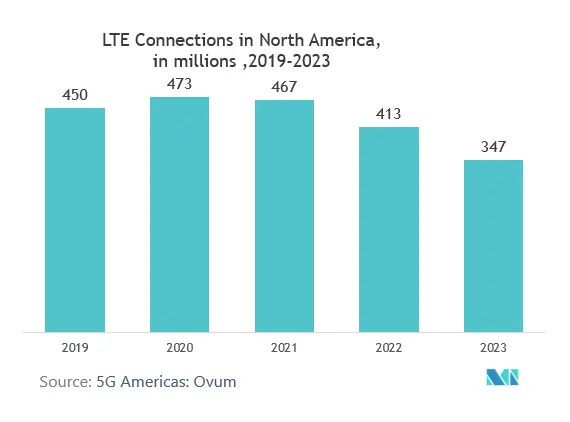
Display Device to Hold the Highest Market Share
- WiGig technology is also being used in broadcasting video signal transmission systems in sports stadiums and mm-Wave video video-signals transmission systems. The technology could also be used for beaming full HD video in real-time and could be used by notebooks and other computers to wirelessly connect virtually, all the expansion needed for a docking station, including a secondary display and storage computer.
- It can further power a high-resolution virtual reality headset in the same room, wirelessly. The WiGig technology, which uses a short-range 60-gigahertz radio, can transfer data at fast enough rates to feed VR imagery from a PC to the display in a VR headset.
- For instance, HTC's Vive wireless adapter uses WiGig technology. Also, in 2019, HTC announced the Vive Cosmos, its next-generation tethered VR headset, which promises numerous improvements along with modularity for further upgrades. Alternatively, the VR HMD can be further equipped with a WiGig-based wireless adapter from HTC.
- The high internet penetration, along with large smartphone users in the region driven by the United States and Canada, is expected to drive the demand for Wi-Fi with high speed in gigabytes using WiGig. North America is quickly migrating toward multi-gigabit, residential internet access, primarily using fiber to the home. The economic feasibility or extracting more bandwidth from existing networks using DOCSIS 3.1 is trending with the real opportunity of wireless and speed, by which the demand of WiGig is increasing in this region.
- According to ASSIA, Inc., there is 80% increase in PC/phone upload traffic since beginning of March in the United states, with webcams, laptops, and PCs running video streams all the time. Wi-Fi networks are uploading data like never before, and a lot of teleconferencing, online education, and even telemedicine applications are not working properly due to network problems. In such instances of high network demand, the prevailing situation of COVID-19 outbreak, could fuel the growth of the WiGig market.
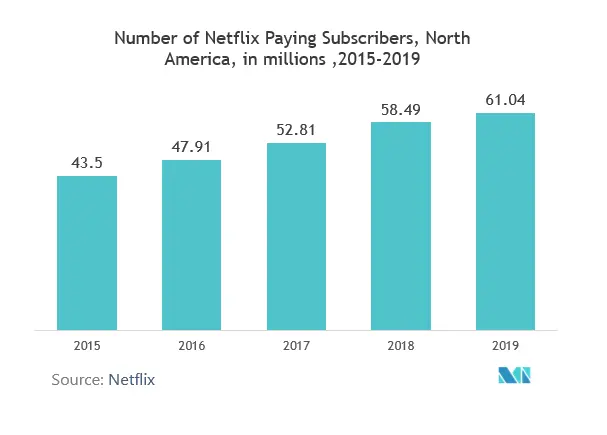
North America WiGig Industry Overview
The WiGig Market in North America appears to be concentrated due to the presence of a small number of vendors. This industry research report offers information about the competitive environment among players in this market space. Major players include Google, Facebook, Intel, Infineon, Qualcomm, among others.
- December 2019- Qualcomm introduced a Snapdragon 8c's Kryo 490 CPU, which designed with an X24 LTE modem to offer 30 percent better performance than the Snapdragon 850 (and 10-30 percent lower than the 8cx). The company has replaced a Wi-Fi 6 from the spec with 802.11ac Wave 2 and 60GHz 802.11ad WiGig.
- December 2019- Intel announced to acquire an Israel-based AI chip start up Habana Labs by investing over USD 2 billion. The company specializes in developing programmable AI and machine learning accelerators for cloud datacenters and have raised over USD 75 million in venture capital. With this acquisition, Intel has planned to advance its AI strategy, which is to provide customers with solutions to fit all performance need from the intelligent edge to the datacenter.
North America WiGig Market Leaders
Qualcomm Technologies Inc.
Intel Corporation
Broadcom Inc.
Cisco Systems Inc.
Dell Technologies Inc.
*Disclaimer: Major Players sorted in no particular order
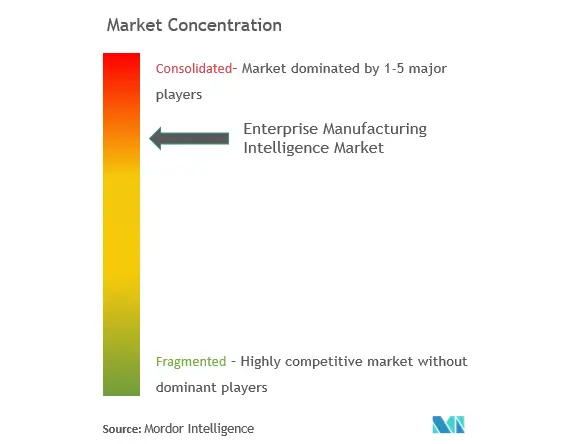
North America WiGig Market Report - Table of Contents
-
1. INTRODUCTION
-
1.1 Study Assumptions and Market Definition
-
1.2 Scope of the Study
-
-
2. RESEARCH METHODOLOGY
-
3. EXECUTIVE SUMMARY
-
4. MARKET DYNAMICS
-
4.1 Market Overview
-
4.2 Market Drivers
-
4.2.1 Growing Technological Advancement in Communication Industry
-
4.2.2 Rising Adoption of High-resolution Videos
-
-
4.3 Market Restraints
-
4.3.1 Shorter Operating Range of WiGig Products
-
-
4.4 Value Chain Analysis
-
4.5 Porters Five Force Analysis
-
4.5.1 Threat of New Entrants
-
4.5.2 Bargaining Power of Buyers/Consumers
-
4.5.3 Bargaining Power of Suppliers
-
4.5.4 Threat of Substitute Products
-
4.5.5 Intensity of Competitive Rivalry
-
-
4.6 Technology Snapshot
-
-
5. MARKET SEGMENTATION
-
5.1 Product
-
5.1.1 Display Devices
-
5.1.2 Network Infrastructure Devices
-
-
5.2 Application
-
5.2.1 Gaming and Multimedia
-
5.2.2 Networking
-
5.2.3 Other Applications
-
-
5.3 Country
-
5.3.1 United States
-
5.3.2 Canada
-
-
-
6. COMPETITIVE LANDSCAPE
-
6.1 Company Profiles
-
6.1.1 Qualcomm Technologies Inc.
-
6.1.2 Intel Corporation
-
6.1.3 Broadcom Inc.
-
6.1.4 Cisco Systems Inc.
-
6.1.5 Dell Technologies Inc.
-
6.1.6 Lenovo Group Limited
-
6.1.7 HP Development Company LP
-
6.1.8 Tensorcom Inc.
-
- *List Not Exhaustive
-
-
7. INVESTMENT ANALYSIS
-
8. FUTURE OF THE MARKET
North America WiGig Industry Segmentation
WiGig, also known as 60GHz Wi-Fi, refers to a set of 60GHz wireless network protocols. This enables high-performance wireless data, display, and audio applications. WiGig transfers data wirelessly on the 60 GHz frequency, unlike Wi-Fi 6 and other normal versions of Wi-Fi that use the 2.4GHz or 5GHz frequencies. In other words, WiGig allows Wi-Fi devices to access the uncongested 60 GHz frequency band with wide channels to transmit data effectively at multi-gigabit per second speeds.
| Product | |
| Display Devices | |
| Network Infrastructure Devices |
| Application | |
| Gaming and Multimedia | |
| Networking | |
| Other Applications |
| Country | |
| United States | |
| Canada |
North America WiGig Market Research FAQs
What is the current North America WiGig Market size?
The North America WiGig Market is projected to register a CAGR of 18.9% during the forecast period (2023-2028).
Who are the key players in North America WiGig Market?
Qualcomm Technologies Inc., Intel Corporation, Broadcom Inc., Cisco Systems Inc. and Dell Technologies Inc. are the major companies operating in the North America WiGig Market.
North America WiGig Industry Report
Statistics for the 2023 North America WiGig market share, size and revenue growth rate, created by Mordor Intelligence™ Industry Reports. North America WiGig analysis includes a market forecast outlook to 2028 and historical overview. Get a sample of this industry analysis as a free report PDF download.
